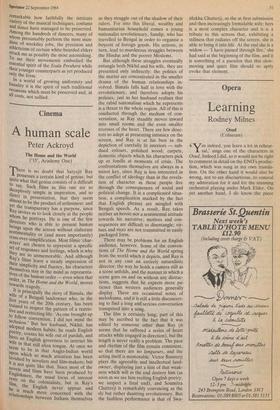Arts
Kandy camera
Giles Auty
watching TV documentaries about Third World countries, a horrid suspicion gnaws that if cannibal rituals were still taking place somewhere then `First World' TV crews would be at hand to film them. Nor would any degustation begin until one of those ubiquitous, bossy TV girls had given the appropriate signal. How has it come about that the entire 'undeveloped' world with its immemorial rituals, magic and savagery now seems regarded as a voyeur's playground by the western media?
Harbouring such suspicions, it should have been no surprise when a British camera crew and miscellaneous jogging- shorted photographers suddenly material- ised in the throng below me during the last climactic night of this year's Esala Perahera at Kandy.
The major purpose of this annual perahera (procession) which takes place in the lunar month of Esala, is to parade the Sacred Tooth of the Buddha which is housed in a magnificent temple in the city during the rest of the year. On ten succes-
sive days, ending with the first full moon in August, crowds line the route as much as 12 hours before the nightly procession moves off.
In the heat of the Sri Lankan day, even in the hill city of Kandy, the presence in the crowds of complete families ranging from toddlers to great-grandparents argues considerable devotion and powers of en- durance. During afternoon and early even- ing, tension, fervour and exhaustion mount. Possibly each is an equally vital element in the total experience.
By the time tropical darkness descends with unsubtle haste, overt preparations for the nightly event are already advanced. Tens of thousands of tiny white lights suddenly transform the Temple of the Tooth into an improbable confection. Meanwhile, the nervous figure who edges along a parapet to coax into life a cluster of reluctant bulbs indicates that this is an evening when nothing must go wrong. Such care in a country where almost anything mechanical or electrical is as likely as not to be unserviceable is doubly Impressive. So, too, is the miraculous nightly ability to organise a procession comprising 90 or so elephants plus a cast, literally, of thousands. Given the standards of organisation prevailing at, say, Colombo airport, it becomes hard not to see in such success the hand of the Divine.
By evening scores of elephants, which find daytime employment as organic fork- lifts; have trudged paths to the city. It is only then that the mysterious depositing outside the temple of a dozen or so car batteries is finally explained. Each tusket gets a 12-volt power supply neatly roped to his shoulders as part of a lengthy capar- isoning. Only when all such preparations are complete does the elephant entrusted to carry the sacred relic of the Buddha emerge from the temple. Torchbearers, dancers and musicians accompany this and all other parts of the procession. Seeking a, western comparison, I could think only 0' ii Palio di Siena, except that in Kandy the purpose of the pageantry is fundamentallY religious. Whether this last was entirely clear to the throng of western cameramen, direc- tors, photographers, sound technicians and suchlike seemed uncertain. Possibly the way some of the TV girls wore their sunglasses pointing heavenward was in- tended as a mark of respect for the occasion, since I could think of no likelier, explanation for wearing dark glasses Well after sundown.
Watching the antics of the camera people, I could not help wondering, whether they would behave with etIna' intrusiveness at, say, Lourdes or Fatinia. Or had the whole occasion been secretly arranged for their benefit? Was I, in fact' watching the ultimate TV production? As the sounds of conch and drum nailed the beginning of a dance blond of extraordinary complexity, one hirgl,_ photographer was so overcome that IS' was forced to try out some of the steps th! himself and as a result became entangle' with the performers. His companions meanwhile handed out cigarettes to the passing torchbearers, possibly as a mark of western thoughtfulness. For two hours, the component proces- sions of Dalada Maligawa the sacred relic: Natha the deified Buddha-to-be, Vishnu guardian of Sri Lanka, Skanda god ofvi"' and victory, and Pattini goddess of chasttrY. go by in a continuous train. Only tfl'A passing of the last of the torch-spinners an"e presence of a vast throng following t12, final performers re-awakened me to M; endless rapacity of tropical night insect. and the realisation that my initia annoyance at the behaviour of fellow d, Europeans had finally evaporate ke charmed away by the magnificence of t'' pageant and the explanatory helpfulness of Sri Lankan neighbours. The Sri Lanka Tourist Board describes the Esala Perahera as the public express: sion of the culture and ritual, life and falr,", of the Sinhala people' and it is certain', remarkable how faithfully the intricate variety of the musical techniques, costume and dance have managed to be preserved. Among the hundreds of dancers, many of whom presumably perform the most mun- dane of weekday jobs, the precision and athleticism of certain white-bearded elders struck me as possibly the most astonishing. To me their movements embodied the essential spirit of the Esala Perahera while their younger counterparts as yet produced only the form.
In a world of growing uniformity and banality it is the spirit of such traditional occasions which must be preserved and, at all costs, not sullied.











































 Previous page
Previous page